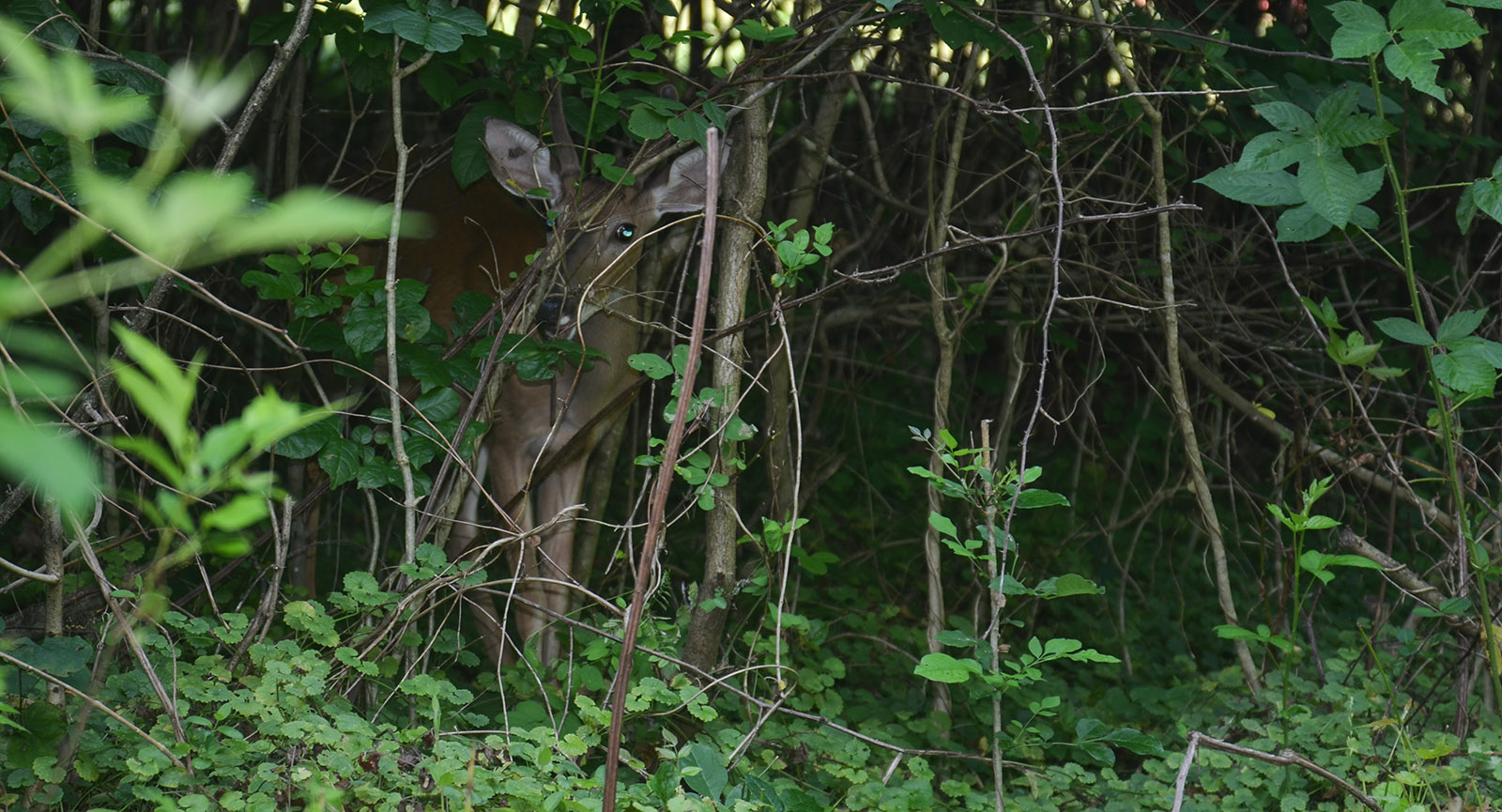By Bruce Ingram
Photos by Bruce Ingram
For many years, the Virginia Deer Hunters Association (VDHA) has been at the forefront of conservation groups advocating for more active forest management in the Old Dominion. In addition, this management should include both our public and private lands not only in the Commonwealth, but also throughout the country. Management that is more active would not only be beneficial for big game animals such as deer and bear and gamebirds such as grouse, woodcocks, and turkeys, but also for a host of songbirds and non-game mammals, reptiles, and amphibians. More active management would even mitigate the negative effects of the West’s catastrophic wildfires. Here is the case for more management from leading conservation organizations.
The Scientific Case for More Management
Matt Ross, assistant director of conservation for the National Deer Association (NDA), and Brent Rudolph, former chief conservation and legislative officer for the Ruffed Grouse Society, present the case for more forest management.
“With all living things, an ending is inevitable,” Ross said. “The same hold true for forests. Whether a tree grows on public land, privately-owned ground, or in Brooklyn–each individual will eventually die and be replaced by another form of plant life, good or bad. That’s potentially an incredibly sobering thought… that we are at the mercy of the cycle of life.
“Or it may be just the thing that helps us realize we have an opportunity here in our short time on earth to have a say in what grows next—to improve the situation at hand and have a positive impact on the flora and fauna that live in that very forest, as well as water/air quality and much more. In simplest terms, forest management allows us to use science, applying methods that have been proven effective from past experience to achieve a desired result: a more healthy forest and biota based on our desired objectives. To do that, we’re going to have to cut some trees.”
Rudolph agrees about the need for forest management.
“In the past, economic factors pushed logging operations to occur more intensively and widespread than was sustainable–either in terms of wildlife habitat or continued sustenance of jobs and income from those industries,” he said. “Overharvest dried up those jobs and industries, and led to well-intentioned (and at the time, needed) protectionist practices and attitudes that in many cases have stayed in place too long.
“We now have an abundance of old, second-growth forests that have all progressed through successional stages at the same rate. Successful conservation and wildlife management requires us to learn lessons from the past and apply both ecological and social principles to sustain a future for healthy, diverse forests and wildlife habitat,” Rudolph said.

The lack of young forests on many of our nation’s public lands is a reason deer numbers have sharply declined on them. Deer fawns need young forests and regenerating clear-cuts as places to both hide and feed, thus be safe from predators.
Ross and Rudolph agree that we need all kinds of forests from old growth to recent clear-cuts, and every age of forest in between. Some songbirds and gamebirds (think grouse) need regenerating woodlots of five to 10 years of age, while others do best with pole timber or stands 20 to 30 years old. And while creating these diverse forests, we need to make sure that we protect the rivers and headwater streams on our public lands, as they are a vital source of drinking water in Virginia and throughout much of the country. In short, the more diversity we have in our national forests and other public and private lands, the better it will be for Virginia’s and America’s wildlife–and us.
Specific Examples of More Management in Virginia and the East
Kip Adams, chief conservation officer for NDA, agrees with Ross and Rudolph and cites two examples of projects his organization has promoted on public forests. In 2015, NDA supported a plan to conduct timber harvesting and controlled burns on the Nantahala and Pisgah national forests in North Carolina. Then, in 2020, NDA favored a major timber thinning project on the George Washington and Jefferson National Forests (GWJNF), which lie, of course, in Virginia, West Virginia, and Kentucky. Of the 1.8 million acres in the GWJNF, nearly 90 percent of it is more than 70 years old.
Not only is that lack of diversity harmful to populations of deer, turkey, woodcock, and grouse, but also to many songbirds such as golden-winged warblers, prairie warblers, yellow-breasted chats, white-eyed vireos, and numerous others that require young forests to live and reproduce. Consequently, these songbirds have dramatically decreased in number, as have the game animals previously mentioned. Older forests have many important features, but their typically closed canopies preclude the growth of understory that provides food, cover, and breeding areas for numerous species of game and nongame wildlife.

This young buck on the author’s Botetourt County land finds both food and safety in this regenerating clear-cut–a type of habitat sadly lacking on many of the nation’s public lands.
Adams believes these and other projects can be accomplished to benefit wildlife, and at the same time protect water sources and promote diversity within our public forests.
“Forest management is an art and a science, and it takes the blending of the two to be successful,” Adams concluded. “Numerous wildlife species rely on forested habitats, and many require a mix of age classes to fulfill their habitat needs. Given that few wildlife species survive exclusively in a single age class of forest, and that forest succession continually marches toward an area’s climax species, management programs are necessary to maintain healthy forests and biodiversity in the wildlife communities.
“Fortunately, silvicultural practices such as timber harvesting and prescribed burning can provide the range of habitat conditions needed by species ranging from frogs to songbirds to whitetail deer,” Adams continued.
Out West
Matt Lindler, director of conservation communications for the National Wild Turkey Federation (NWTF), says public forests in the West would similarly benefit from more forest management.
“Many people do not realize that the security of our nation’s water supply depends on our forests,” he said. “Forests are at the heart of the watershed systems that feed thousands of communities and millions of people. Catastrophic wildfires are the biggest threat to watersheds in the West and can severely impact surface-water infrastructure.
“High-intensity wildfire kills trees, brush, undergrowth, and grasses; all of these things normally prevent erosion. Without organic structure in the soil, it becomes unstable, and as surface water from snowmelt and rain flows toward the streams, rivers and reservoirs, it picks up silt and debris, carrying it into the downstream infrastructure, natural and man-made.”
Lindler adds that active management practices performed before a potential wildfire improves forest and habitat health and can decrease wildfire impacts to the forest and watershed. Healthy forests and watersheds provide quality and abundant water. These things are true in not only the West, but also in Virginia and in any other state.
“This is why active forest management is so important in the West and why the NWTF is conducting and promoting work on public and private lands in the region,” Lindler said. “Removing dead, standing trees killed by insects, disease, or previous fire is one piece. Another is regular thinning combined with prescribed fire, where it is feasible, to remove debris that has built up over decades. This helps create resilient forest landscapes that can easily withstand a natural wildfire cycle, protecting vital watersheds, wildlife habitat, recreational opportunities and, ultimately, communities.”
The Case for More Management Locally
Nationally, leading voices in conservation have made the case for more active forest management, but VDHA members should also act locally to advocate for more timber management. I have done just that on the six properties I own and manage in Virginia and West Virginia. For example, on my 140-acre property in the Sinking Creek Valley of Craig County, I’ve created several sections of young forest. This habitat benefits songbirds such as yellow-breasted chats, white-eyed vireos, chestnut-sided and prairie warblers, and especially the increasingly rare golden-winged warbler.
In the previous decade, I enrolled my land in the Working Lands for Wildlife program as part of the Natural Resources Conservation Service’s Golden-Winged Warbler Initiative. Across its range, this songbird’s numbers have plummeted for numerous reasons, with one of the chief ones being a lack of young forests on public and private land. With cost-share money, I created clear-cuts and savannah-like habitat, planted warm-season grasses such as little bluestem, and thinned other sections so that more oaks and cherries could flourish. Golden-wings relish the caterpillars attracted to these trees. And yes, I was more than a little aware that the habitat improvements I was doing on my land would make it more inviting for deer and turkeys.

This young forest has been thinned which will result in better mast production. More of this type of activity needs to take place in our national forests and other public forests
Kent Davis, president of the Roanoke Valley Bird Club, told me that his club members, as avid birders, recognize that many songbirds have decreased in number because of the lack of young forests. Davis also emphasized that birding organizations such as the American Bird Conservancy are also advocating for more young forests. Some VDHA members may be surprised that non-hunting organizations are also advocating for more forest management, but maybe they shouldn’t be. The science is clear on this need, and we should be reaching out to groups and individuals to promote that need.
We can also advocate for more active management in our own neighborhoods. For example, in 2010, I decided that much of the forest on the 38 acres that my wife Elaine and I live on in Botetourt County was in need of some habitat diversity. The western and eastern sides of our land especially needed to be cut because of the Virginia pine-dominated forest there.
While contemplating the two clear-cuts on my land, I noted that the three properties that adjoined the western and eastern sides also had older Virginia pine-dominated woodlots. So, I individually contacted all three families, detailed the need for active forest management, and explained how a timber harvest would be good for wildlife and the health of their forests, and put money in their pockets as well. All three families agreed to participate in the clear-cuts, and everyone was satisfied afterwards.
Of course, whether VDHA members are advocating for more forest management nationally, regionally, or locally, there will be groups and individuals who will refuse to see the science and logic. After the clear-cuts on our land and my bordering neighbors was completed, I learned that a property owner on the opposite end of the road had declared that his Virginia pine stand would never be cut and one day become “old growth forest.” An illogical claim for a tree species that lives only 60 or so years.
The Case for More Management Regionally in Virginia
Botetourt County’s Mike Wolfe is a VDHA member and on the board of directors for the Appalachian Habitat Association. The AHA strives to preserve and improve wildlife habitat on public lands (with an emphasis on the George Washington and Jefferson National Forests) for all species of wildlife. The organization concentrates its efforts in Alleghany, Augusta, Bath, Botetourt, Craig, Highland, and Rockbridge counties. Wolfe says that since the organization was founded in 2018, the group’s efforts have improved the wildlife habitat on more than 1,000 acres of the GWJNF that lies in those seven counties.
“The National Forest Service and the Virginia Department of Wildlife Resources (DWR) don’t have the staff to do everything they need to do to improve wildlife habitat in our coverage area,” Wolfe said. “So, our organization fills in the void however we can. For example, my area of expertise is native grasses and pollinators, so I’ve helped create/improve some 165 acres for pollinators in the national forest.
“Other board members have their own areas of expertise, as well. For example, Wayne Anderson and Jim McCoy are very knowledgeable about improving deer habitat, so they take the lead on projects involving deer,” continued Wolfe.
I truly believe that in the years to come, young forest advocates will have more successes than failures when we present our case. Again, science and logic are on our side.
Bruce Ingram, staff writer for Whitetail Times, lives in Fincastle, Virginia with his family. Ingram is a serious whitetail hunter and fisherman. His hunting and fishing articles have been published in state, regional and national publications. He welcomes and looks forward to hearing from readers via e-mail be_ingram@juno.com with their questions and comments about his articles in Whitetail Times.
©Virginia Deer Hunters Association. For attribution information and reprint rights, contact Denny Quaiff, Executive Director, VDHA.



